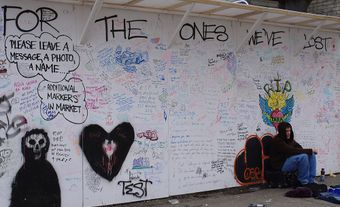This article was originally published in Maclean’s magazine on January 31, 2000. Partner content is not updated.
Perhaps, but if Rock gets his way cigarette packaging is about to go from colourful and cool to downright disturbing.Cigarette Packaging
Arthur Kaznowski takes a long drag on the cigarette burning beneath his wispy teenage moustache and considers the picture of two human lungs. One is healthy and pink; the other, which once belonged to a smoker, is black and tumour-ridden after years of inhaling noxious tobacco smoke. Last week, Health Minister Allan Rock announced a sweeping proposal that he hopes will jolt smokers into quitting - or keep non-smokers from starting. He intends to force manufacturers to print startling photos of diseased lungs and mouths - like the ones Kaznowski is looking at - on cigarette packages. But as they consider the images in their smoking spot outside Jarvis Collegiate Institute in downtown Toronto, 17-year-old Kaznowski and his friends are dismissive. "If people want to try smoking they will," says Kaznowski, passing his cigarette to a friend. Glancing at the damaged lung, he adds: "This won't stop them."Perhaps, but if Rock gets his way cigarette packaging is about to go from colourful and cool to downright disturbing. The changes, considered to be among the toughest proposed anywhere in the world, would force manufacturers to dedicate half the front panel of every cigarette pack to any of 16 shocking images. Aside from stark close-ups of tumours, they include a pregnant woman smoking along with the slogan "Cigarettes hurt babies," and a drooping cigarette labelled "Tobacco use can make you impotent." In addition, a leaflet inside the package will list the toxic chemicals in tobacco smoke and advise smokers how to kick their habit. With more than two billion cigarette packs printed annually in Canada, it will amount to the biggest public-health campaign ever launched here. "Canadians who use tobacco," said Rock, "need to fully understand the serious health hazard inherent in this lethal product."
Not surprisingly, the tobacco industry said it intends to block Rock's proposals before they are to go into effect next year. Industry spokesman Rob Parker, president of the Canadian Tobacco Manufacturers' Council, said Rock's plan is unworkable because the companies that print the packages cannot produce the new images the minister wants. Printing industry executives swiftly contradicted Parker, however, saying they could duplicate the images. But Parker also questioned whether the stark warnings are necessary. "People smoke because they are risk-takers," he said. "Risk is part of the pleasure of smoking."
Increasing awareness of the risks associated with smoking is precisely what Rock has in mind. Health officials believe the printed warnings that have been on cigarette packages since 1994 have lost much of the impact they might have had. During the past decade, the number of smokers has fallen slightly, from 30 per cent of Canadians over the age of 15, to 25 per cent. But at the same time, the number of teenage smokers has increased to 28 per cent of that age group from 21 per cent.
Seeking to determine if a different approach to packaging could help reduce smoking further, Health Canada hired Toronto-based Environics Research Group Ltd. in 1998 to sample public opinion. In five separate studies - four among adults and one among young people aged 12 to 18 - the firm found all groups considered graphic warnings to have far more impact than printed notices. That was particularly true among the young, Environics reports, with 88 per cent under 18 saying the new images would be a greater deterrent. Julia Ford, a 17-year-old non-smoker at Jarvis Collegiate, agrees. "The pictures might not make you quit if you already smoke," she says, "but they could stop you from starting."
In addition to their shock value, the new images are part of a larger campaign to deglamorize smoking and make it socially unacceptable. Cigarettes retain an aura of legitimacy, says Roberta Ferrence, director of the Ontario Tobacco Research Unit at the University of Toronto, in part because they are sold from attractive, colourful displays, often located near milk, bread and other healthy products. But when store shelves are lined with cigarette packages portraying the ugly results of smoking, she adds, people may begin to recognize tobacco for the deadly product that it is.
The new packaging plan also got a thumbs-up from Richard Pollay, a marketing professor at the University of British Columbia, who feels it could fundamentally change how consumers view cigarettes. "The packages will no longer be a symbol of status," said Pollay, a leading expert on tobacco advertising, "particularly among teenagers." First, however, the new regulations must be put into effect - and both the Reform party and the NDP have voiced their support. Then they will likely face a court challenge from the tobacco industry. But as she puffs on her cigarette in a Toronto mall, Teresa Palmer, 25, says she wishes the graphic warnings had been around earlier, when she got hooked. "When you're a teenager," she says, "you never think you will die." The new cigarette packages just might help drive home a stark lesson in life.
Maclean's January 31, 2000

 Share on Facebook
Share on Facebook Share on X
Share on X Share by Email
Share by Email Share on Google Classroom
Share on Google Classroom


